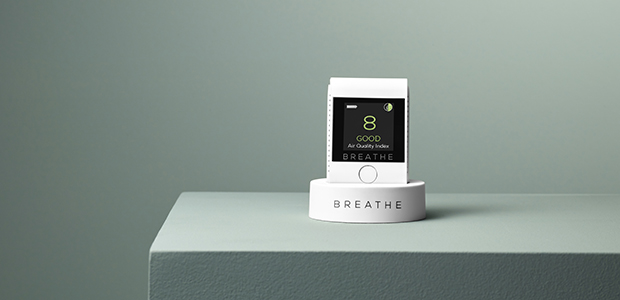
Breathing new life into air quality monitoring
As parent to a young child growing up in London, entrepreneur Chris Turner wanted a greater understanding of the air quality in the capital and how it impacts on peoples’ lives and that of his family. However, when he failed to find the air pollution monitor that he was looking for, he decided to set up his own company, BREATHE Tech, and create his own. Startups Magazine caught up with him to find out more.
With the global population on the rise our cities are becoming increasingly congested, which has resulted in a significant rise in the number of deaths attributed to air pollution over the last decade, to the extent that it is now linked to more fatalities than tobacco.
The deadliest form of air pollution is particulate matter (or PM) 2.5 - the 2.5 indicates that it is 2.5 nanometres across, which equates to around 1/30th of the width of a human hair. Its minute size means that it can penetrate deep into the lungs, and from there the bloodstream, causing all manner of short- and long-term health issues from irritation of the eyes, nose and throat, to heart disease and cancer.
While PM2.5 impacts everyone, those particularly at risk are the elderly, children (due to the increased rate of their breathing and the immaturity of their respiratory organs), people with heart disease and breathing problems, and pregnant women (studies have shown that these tiny particulates have been found in the placentas of unborn babies).
In 2014, it was estimated that around 90% of the population living in cities was exposed to particulate matter in concentrations exceeding the World Health Organisation (WHO) air quality guidelines.
The spark of idea
With these sorts of headlines swirling around, it was obviously not an ideal environment to raise a child, as Turner explained: “Your perspectives change when you become a father. Suddenly you have this little bundle that you are responsible for, and I became very concerned about the impact of the lifestyle choices that I’d made and the decision to live in London.”
Turner explained that when he researched the air quality monitors available, he discovered that they tended to be complex and difficulty to use. And so, with a background in product sourcing and experience in how to bring an idea to market, he began making one of his own.
This included visiting manufacturing sites in China, and around six months of working on a concept. He continued: “Once I’d set upon an idea and a design that I thought would work, I launched on Indiegogo in November 2018, finishing in January 2019, and have spent the last year turning that crowdfunding into a retail product - we started selling in August.
“There are so many gadgets and apps out there, but I was of the opinion that our product needed to be something that would fit into consumers’ lifes easily, otherwise it would just be thrown into a draw and forgotten about.”
The BREATHE|Smart monitor constantly measures and displays real-time concentrations of harmful air pollution particulates, so users can reduce their exposure to toxic air and minimise the associated negative health effects. The monitor comes with everything you need to measure toxic particulate pollution at home and on the go - with the integrated clip and included strap, BREATHE|Smart attaches to bikes, buggies, strollers, prams, and bags.
USP
It’s this level of portability that Turner believes sets the BREATHE|Smart monitor apart in what is a competitive market. “The sensor we are using is the best and most compact out there in terms of the technology it uses and its size,” he continued. “We’ve made a significant investment in R&D and as such, it’s the best and most accurate sensor you can get in this level of product.”
Turner explained that BREATHE|Smart is the smallest monitor of its type and is the only one on the market that’s portable in the purest sense of the word. “Other companies that are bigger than mine will sell you a monitor that you can take out with you, but then if you want to view the readings you need to take out your smartphone and view them on an app, which is inconvenient and impractical,” he added.
With the BREATHE|Smart monitor the user has instant read-outs which change quicker than once every second, depending on the prevailing pollution conditions. And it’s this rapid monitoring that is another feather in the cap of BREATHE|Tech.
There is conclusive proof that the differences in pollution levels is vast, not just from one street to another but from different sides of the same street. The particulate matter that BREATHE|Smart are measuring can vary greatly within the space of just a few feet. “That’s why I wanted our product to not only be portable, but to have the information right there in front of you – if a dirty diesel bus drives past, you will see the impact on the air around you immediately,” added Turner.
It’s due to this fluid level of change in air quality that predictive apps have issues when it comes to accuracy, and merely offer a forecast and a prediction. In reality, air quality will vary enormously depending on traffic flow and type of traffic, weather conditions, etc, so Turner stressed that a prediction isn’t really that valuable.
Indoor education
When it comes to pollution, it’s not just about the stereotypical diesel belching buses and trucks cluttering our roads. What is less understood is that we spend as much as 80% of our time indoors where many seemingly harmless activities can increase exposure to pollutants. And the infancy of the market creates its own challenges in terms of educating people of the dangers of air pollution in the home.
Turner continued: “The great thing about crowdfunding is that the early adopters that you meet through the platform are keen to give feedback, so I’ve had a lot of interaction with the people that have backed us. A recurring theme is the level of surprise of these early adopters when they site the monitor in their kitchen, for example. Every time they cook the air pollution levels go off the scale, and creates a hazardous environment, which they didn’t expect when they were merely cooking the evening meal.
“It really is a wake-up call. Until you have one of our monitors in your home, you wouldn’t believe the impact of something like burning the toast can have on the air quality in the kitchen, and just how long afterwards that the air can remain at a hazardous level.
“It’s doing people harm, so by having that information in real-time and at peoples’ fingertips the hope is that people will better understand the dangers and introduce changes to improve their health and that of others.”
Turner explained that people wrongly assume that air quality in buildings will axiomatically be better than it will on the street. However, modern buildings are built with quality insulation so adequate ventilation is limited.
One of the bigger risk factors of PM2.5 is how this particulate pollution can be harmful over sustained periods of exposure when inside - particularly the elderly and young children who spend a significant amount of time indoors. It’s obviously very important to insulate our modern homes correctly to help reduce energy, but the truth is that it can spell bad news for ventilation and air quality.
Another issue is that wood burners and open fires are currently very on trend. Burning any combustion fuels like coal, heating oil, and wood, can create PM2.5, and Turner explained that, in terms of air quality, you couldn’t put anything worse in your home than an open fire. In a slightly surprising revelation, he explained that two countries with notoriously bad indoor air quality are Canada (one of BREATHE|Tech’s biggest markets), and New Zealand, due to the popularity of open fires in those locations.
A global problem
It’s erroneous that, when we think of polluted cities, our thoughts immediately turn to China or India. While these cities are certainly congested and polluted, Tuner explained that London is by no means a clean city, and poor air quality is a global problem.
“London is in fact quite bad,” he continued. “In 2017 the city breached the air quality limits for the whole year in five days. It was slightly better last year but the capital is certainly not at the standard where we might expect it to be.”
He added that the understanding of the damage that this particulate matter is doing to people is relatively recent. Going back to the 1950s, the Government acted to reduce the issues around coal pollution and smog control which led to an improvement in air quality. However, with the growth of diesel vehicles this went into reverse, which has been exacerbated by the return of people burning materials and the growth of wood burners and open fires.
To further ease the situation going forward BREATHE|Tech are planning to launch a personal air purifier for the home, and a new WiFi and Bluetooth enabled monitor that will plot your exposure on a map.
“We’re at a stage now where we are able to tell you air quality is bad, the next step is fixing it. The current BREATHE|Smart monitor is available now on Amazon, our first air purifier will be available in January next year, with the WiFi/Bluetooth monitor coming in August.”
Early stage startup advice
For Turner, he stressed that there are lessons to be learned on the funding journey. He concluded: “I didn’t go into the crowdfunding process naively – I listened to every podcast and read every article. I thought I understood it completely, but I didn’t.
“Crowdfunding can seem like a very easy way to raise money and get exposure. I knew that you had to put in the groundwork, but even then I was surprised at how hard it was to gain traction and get support, even though I had built a list of over 3,000 email addresses and did some Facebook advertising (at great expense through a marketing agency).
“I would certainly offer it as a warning to people that even if you think you’ve got the greatest product in the world, it doesn’t mean that people are going to listen and automatically flock to your funding page.”


